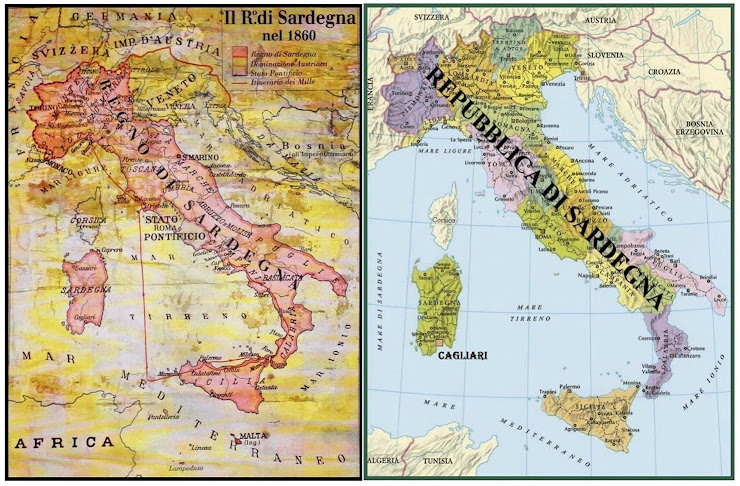Il Popolo Sardo Libero
Delle Isole e della Penisola di Sardegna
giovedì 31 gennaio 2019
PER SABATO 2 FEBBRAIO ORE 10,30 A SARROCH INVITO A TUTTI I SARDI
INVITO A TUTTE LE AMICHE E AMICI PER SABATO 2 FEBBRAIO ORE 10,30 SARROCH, #SARAS, PRESSO STADIO FLASH MOB PER CAMBIARE IL NOSTRO FUTURO:
CARO-VITA , RISCHI MORTALI e RECESSIONE
FINALMENTE L’ EUROPA AMMETTE :
FINALMENTE L’ EUROPA AMMETTE :
DALLE CRISI NON SI ESCE CON SOLO AUSTERITÀ, LA STAGNAZIONE DEI CONSUMI NON CONVIENE NEANCHE AL FISCO.
PER FAVORIRNE LA RIPRESA, VA SCONTATO IL #CARBURANTE:
UN BENE VITALE PER TUTTI. ANCHE LADDOVE, DELL’ IMMENSA RICCHEZZA, PRIVATA E FISCALE, CHE (CON RISCHI TERRITORIALI LETALI), SI TRATTA E TRASPORTA,
SE NE TENGA UNA PARTE , A GARANZIA REALE DA EVENTUALI DISASTRI O CALAMITA’ SUL GOLFO, CON TRAFFICI D’ ARMI, PETROLIERE (CON GASOLIO E BENZINA) E TRAGHETTI CON GRAVE PREGIUDIZIO ALL’IMMAGINE PULITA DELL’ ISOLA NEL MONDO QUI’ PERO’ NON SI HA RISCONTRO DI CAUZIONI O FIDEJUSSIONI, NE AGEVOLAZIONI IN ATTESA DI TUTELE CHE SALVAGUARDINO DA OGNI CRITICITÀ L’ INTERO CONTESTO, PER UN MIGLIOR RAPPORTO RISCHI-BENEFICI COL FONDO SERVENTE, CHIEDIAMO INTANTO ALLA POLITICA, DI LIMITARE I PREZZI AL CONSUMO LOCALE DI CARBURANTI E ACCISE ;
SE NE TENGA UNA PARTE , A GARANZIA REALE DA EVENTUALI DISASTRI O CALAMITA’ SUL GOLFO, CON TRAFFICI D’ ARMI, PETROLIERE (CON GASOLIO E BENZINA) E TRAGHETTI CON GRAVE PREGIUDIZIO ALL’IMMAGINE PULITA DELL’ ISOLA NEL MONDO QUI’ PERO’ NON SI HA RISCONTRO DI CAUZIONI O FIDEJUSSIONI, NE AGEVOLAZIONI IN ATTESA DI TUTELE CHE SALVAGUARDINO DA OGNI CRITICITÀ L’ INTERO CONTESTO, PER UN MIGLIOR RAPPORTO RISCHI-BENEFICI COL FONDO SERVENTE, CHIEDIAMO INTANTO ALLA POLITICA, DI LIMITARE I PREZZI AL CONSUMO LOCALE DI CARBURANTI E ACCISE ;
SABATO 2 MATTINA A #SARROCH, TRA STADIO E MERCATO, RAPPRESENTANTI DI ASSOCIAZIONI, COI GILET GIALLI E CITTADINI, CHIEDONO PROVVEDIMENTI ALLA POLITICA
E DA DOMENICA, UN IMPEGNO, SUL TEMA, AI CANDIDATI A GOVERNATORE
E DA DOMENICA, UN IMPEGNO, SUL TEMA, AI CANDIDATI A GOVERNATORE
martedì 15 gennaio 2019
domenica 13 gennaio 2019
Pre-Indo-European hypothesis
There is toponymic evidence suggesting that the Paleo-Sardinian language may have had connection to the reconstructed Proto-Basque and to the pre-Indo-European Iberian language of Spain.[4] Eduardo Blasco Ferrer concluded that it developed in the island in the Neolithic as a result of prehistoric migration coming from the Iberian peninsula.[5] The author in his analysis of the Paleo-Sardinian language find only few traces of Indo-European influences (*ōsa, *debel- and perhaps *mara, *pal-, *nava, *sala), possibly introduced in the Late Chalcolithic through Liguria.[6] Similarity between Paleo-Sardinian and Ancient Ligurian were also noted by Emidio De Felice.[7]
Bertoldi
& Terracini[citation
needed] propose
that the common suffix -ara (with
stress on the antepenult)
was a plural marker, and indicated a connection to Iberian or to the
Paleo-Sicilian languages. Terracini claims a similar connection for
the suffix -ànarV,
-ànnarV, -énnarV, -ònnarV,
as in the place name Bonnànnaro.
A suffix -ini also
seems to be characteristic, as in the place name Barùmini.
A suffix or suffixes -arr-,
-err-, -orr-, -urr- have
been claimed to correspond to Numidia (Terracini),
to Iberia (specifically
Basque, Blasco Ferrer), to the south of Italy and Gascony (presumably
Basque, Rohlfs), and to Basque (Wagner, Hubschmid).
The
non-Latin suffixes -ài,
-éi, -òi, -ùi survive
in modern place names based on Latin roots. Terracini sees
connections to Berber. Bertoldi sees an Anatolian connection
in the endings -ài,
-asài (similar
claims have been made of the Elymians of
Sicily). A suffix -aiko is
also common in Iberia and may have a Celtic origin.
The tribal suffix -itani,
-etani,
as in the Sulcitani,
has also been identified as Paleo-Sardinian.
Pre-Nuragic Sardinia
One of the Domus de janas of the necropolis of Monte Siseri, Putifigari
In the Stone Age the island was first inhabited by people who had arrived there in the Paleolithic and Neolithic ages from Europe and the Mediterranean area. The most ancient settlements have been discovered both in central and northern Sardinia (Anglona). Several later cultures developed on the island, such as the Ozieri culture (3200-2700 BC). The economy was based on agriculture, animal husbandry, fishing, and trading with the mainland. With the diffusion of metallurgy, silver and copper objects and weapons also appeared on the island.[11]
Remains from this period include hundreds of menhirs (called perdas fittas) [12] and dolmens, more than 2,400 hypogeum tombs called domus de Janas, the statue menhirs, representing warriors or female figures, and the stepped pyramid of Monte d'Accoddi, near Sassari, which show some similarities with the monumental complex of Los Millares (Andalusia) and the later talaiots in the Balearic Islands. According to some scholars, the similarity between this structure and those found in Mesopotamia are due to cultural influxes coming from the Eastern Mediterranean.
Iscriviti a:
Commenti (Atom)
.

.

Da Regno di Sardegna a Repubblica di Sardegna


